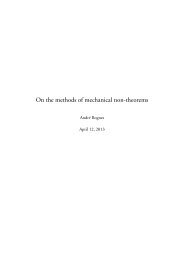Clausal architecture and movement verbs in Malagasy
Clausal architecture and movement verbs in Malagasy
Clausal architecture and movement verbs in Malagasy
You also want an ePaper? Increase the reach of your titles
YUMPU automatically turns print PDFs into web optimized ePapers that Google loves.
<strong>Clausal</strong> <strong>architecture</strong> <strong>in</strong> <strong>Malagasy</strong><br />
constituent t-aiza ‘perf-where’ is an argument of the higher verb n-<strong>and</strong>eha ‘went’<br />
<strong>and</strong> so, when it is fronted, circumstantial passive morphology must appear on the<br />
radical of the govern<strong>in</strong>g verb, as shown <strong>in</strong> (38) s<strong>in</strong>ce not do<strong>in</strong>g so would yield the<br />
irretrievably ungrammatical sequence shown <strong>in</strong> (39).<br />
The latter analysis is based on the way adjunction works <strong>in</strong> <strong>Malagasy</strong>. We now<br />
turn to a description of this process immediately below.<br />
4.2 Adjunction vs. embedd<strong>in</strong>g <strong>in</strong> <strong>Malagasy</strong><br />
In general, we have cases <strong>in</strong>volv<strong>in</strong>g adjunction when the tense or the aspect<br />
markers show<strong>in</strong>g up on two adjacent <strong>verbs</strong> are exactly the same. The follow<strong>in</strong>g are<br />
prototypical examples:<br />
(40) N-i-anatra n-amily fiara i Paoly.<br />
Past-Prf-learn Past-drive a car Art Paul<br />
‘Paul was learn<strong>in</strong>g how to drive a car.’<br />
(41) M-i-anatra m-amily fiara i Paoly.<br />
Pres-Prf-learn Pres-drive a car Art Paul<br />
‘Paul is learn<strong>in</strong>g how to drive a car.’<br />
(42) H-i-anatra h-amily fiara i Paoly.<br />
Fut-Prf-learn Fut-drive a car Art Paul<br />
‘Paul was learn<strong>in</strong>g how to drive a car.’<br />
(43) Ø-lasa t-any Antsirabe i Paoly.<br />
Perf-gone Perf-to Antsirabe Art Paul<br />
‘Paul was gone to Antsirabe.’<br />
(44) *M-i-anatra h-amily fiara i Paoly.<br />
Pres-Prf-learn Fut-drive car Art Paul<br />
‘Paul is learn<strong>in</strong>g how to drive a car.’<br />
In (40) we have a sequence of two <strong>verbs</strong> with exactly the same past tense-marker<br />
n- on the two verb radicals. In (41), the sequence of two <strong>verbs</strong> have exactly the<br />
same present tense-marker m- on the radicals. In (42), the sequence of two <strong>verbs</strong><br />
have the exactly same future tense-marker h- on the radicals. In all three <strong>in</strong>stances,<br />
the portion compris<strong>in</strong>g the second verb represents an adjunct to the higher verb.<br />
Now, if an attempt is made to change the tense on the lower verb <strong>in</strong>to a different<br />
one, as shown <strong>in</strong> (44) for example, the sequence becomes ungrammatical s<strong>in</strong>ce we<br />
no longer have an adjunct.<br />
The same analysis could be applied to the sequence of two <strong>verbs</strong> <strong>in</strong> (43), except<br />
–525–

















